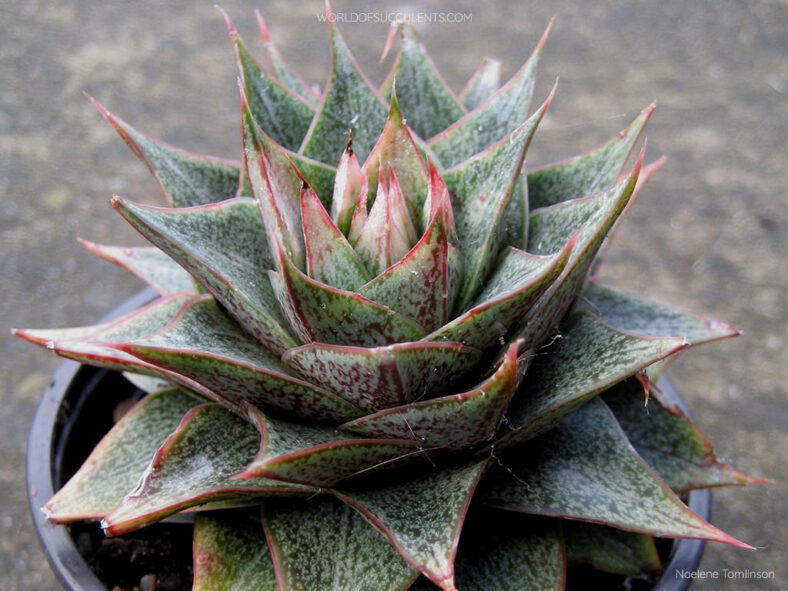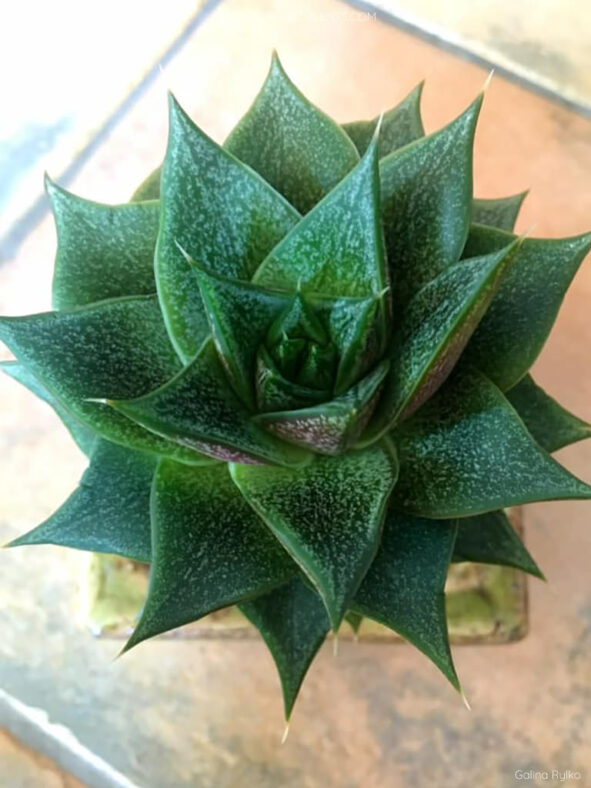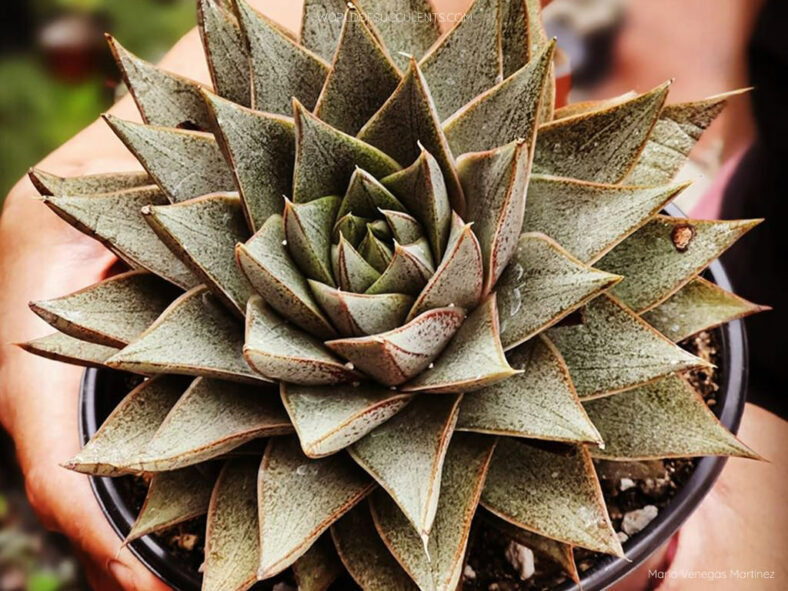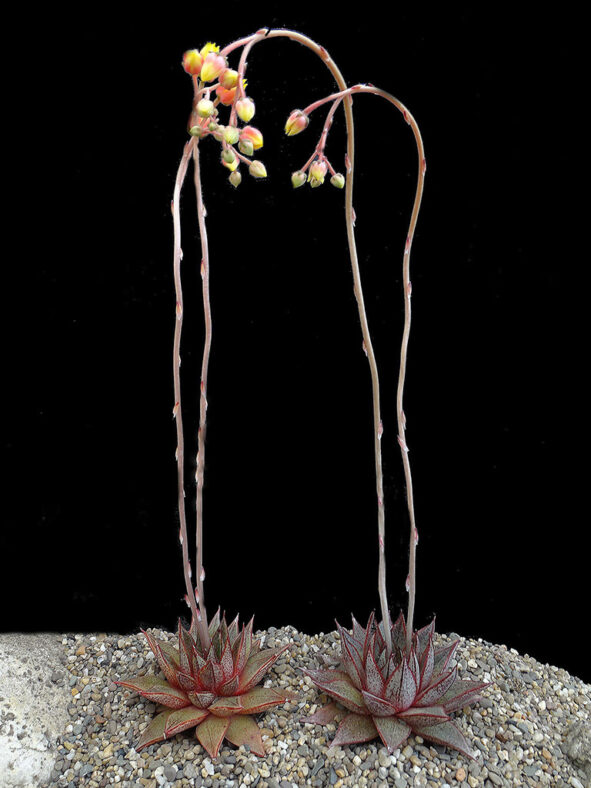This species is quite rare, and most of the plants you see labeled as Echeveria purpusorum are usually hybrids. There are several more or less similar hybrids, one of them being Echeveria 'Dionysos'. Echeveria purpusorum has more slender leaves with a pointier apex, while those of Echeveria 'Dionysos' tend to be plumper.
Scientific Name
Echeveria purpusorum (Rose) A.Berger
Synonym(s)
Echeveria purpusiorum, Urbinia purpusii
Scientific Classification
Family: Crassulaceae
Subfamily: Sempervivoideae
Tribe: Sedeae
Genus: Echeveria
Etymology
The specific epithet "purpusorum (pur-puss-OR-um) honors Carl Albert Purpus and Joseph Anton Purpus, German plant collectors who discovered the species in 1909 near San Luis Atolotitlán in Puebla.
Origin
Echeveria purpusorum is native to southern Mexico. It grows in quite hot and dry conditions in Puebla and Oaxaca.
Description
Echeveria purpusorum is a small succulent plant that forms a compact, usually solitary rosette of deep olive-green, grey-green, or whitish-green leaves mottled with small irregular reddish-brown spots. The rosette grows slowly, reaching up to 3.2 inches (8 cm) in height and diameter, and can occasionally produce a few offsets. The leaves are triangular-ovate, tapering to a sharp point, and can measure up to 1.6 inches (4 cm) long and 1.2 inches (3 cm) wide at the base.
In late spring, the rosettes produce somewhat urn-shaped flowers in few-flowered clusters on slender reddish stalks that can grow up to 12 inches (30 cm) in length. The flowers are scarlet red with a yellow tip on the outside and yellow on the inside, measuring up to 0.5 inches (1.2 cm) long.

How to Grow and Care for Echeveria purpusorum
Light: Echeveria purpusorum requires full sun to partial shade for optimal growth. Therefore, place it near the brightest window in your home. In addition, if you are moving the plant outside in spring, do it gradually and avoid exposure to intense afternoon sun.
Soil: Having soil that drains quickly is most important for growing a healthy succulent. While many growers prefer to create their own soil mix, commercial soil for succulents will work fine.
Temperature: High temperatures are not a problem as long as there is plenty of fresh air, but Echeveria purpusorum is a tender succulent and must be brought indoors if there is a risk of freezing temperatures. It grows best in USDA Plant Hardiness Zones 10a to 11b, with average minimum winter temperatures ranging from 30 to 50 °F (-1.1 to 10 °C).
Watering: During the growing season, the "soak and dry" method is the preferred schedule for this plant. Water deeply and then let the soil completely dry out before watering again. Water sparingly during the winter, only enough to keep the plant from shriveling. Above all, if you have a saucer under the pot, do not forget to empty the excess water.
Fertilizing: Although it can grow well without fertilizer, the plant may benefit from extra nutrients. Feed only during the growing season and use a water-soluble fertilizer diluted to half the recommended strength.
Repotting: If growing it in a container, repot as needed in spring or early summer, but ensure the soil is dry before you start. Also, always use a container with drainage holes.
Propagation: Echeveria purpusorum is usually propagated from leaves but can also be grown from seeds. The best time to take leaf cuttings is spring, while spring or summer are ideal for sowing seeds.
Learn more at How to Grow and Care for Echeveria.
Toxicity of Echeveria purpusorum
Echeveria purpusorum has no reported toxic effects and is safe to grow around children and pets.
Hybrids of Echeveria purpusorum
- Echeveria 'Belle Etoile'
- Echeveria 'Ben Badis'
- Echeveria 'Dionysos'
- Echeveria 'Fabiola'
- Echeveria 'Shamrock'
- ×Graptoveria 'Amethorum'
- ×Graptoveria 'Araluen Gem'
Links
- Back to genus Echeveria
- Succupedia: Browse succulents by Scientific Name, Common Name, Genus, Family, USDA Hardiness Zone, Origin, or cacti by Genus
Photo Gallery
Click on a photo to see a larger version.



